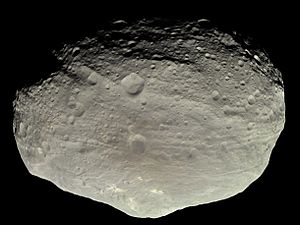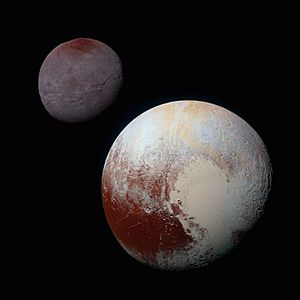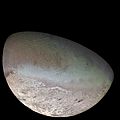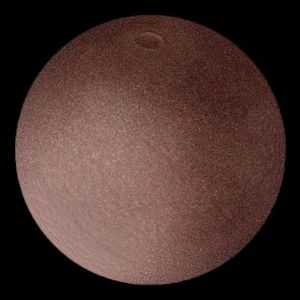Dwarf planet facts for kids
A dwarf planet is a special kind of object in our solar system. Imagine a space rock that's big enough to pull itself into a round shape using its own gravity. That's part of being a dwarf planet! But here's the tricky part: it hasn't "cleared its path" around the Sun. This means there are still lots of other smaller rocks and debris in its orbit.
The name "dwarf planet" was first used by a scientist named Alan Stern. He thought of space objects in three groups: regular planets, dwarf planets, and even "satellite planets" (which are big moons). While some scientists, like Stern, think dwarf planets are a type of planet, the International Astronomical Union (IAU) and most astronomers decided they are a separate group.
Contents
How We Defined Dwarf Planets

For a long time, people thought our solar system had nine main planets. This included Pluto, which was discovered in 1930. But scientists kept learning more about Pluto.
At first, they thought Pluto was bigger than Mercury. But in 1978, they found Pluto's moon, Charon. By studying Charon's orbit, they could figure out Pluto's true size. It turned out Pluto was much smaller than they thought – way smaller than Mercury and even smaller than Earth's Moon.
Pluto also had a very unusual orbit. It wasn't as neat and tidy as the other planets. It swung out far and tilted a lot. This made scientists wonder if it was really like the other planets.
In the 1990s, astronomers started finding many other objects in the same area of space as Pluto, called the Kuiper belt. Some of these new objects were quite large. It became clear that either these new, large objects would also have to be called planets, or Pluto would need a new classification. This is similar to what happened with Ceres way back in the 1800s. Ceres was first called a planet, but then so many other similar objects were found that it was reclassified as an asteroid.
Scientists realized that if all these new, large objects were called planets, the number of planets would quickly grow very large!
The Big Debate About Pluto
In 2005, a new object named Eris was discovered. It seemed to be even a little bigger than Pluto! This really made the debate about what a "planet" is heat up.
In August 2006, the IAU had a big meeting. They discussed how to define a planet. Their first idea was to include Charon, Eris, and Ceres as planets, which would have made 12 planets! But many astronomers didn't like this idea.
So, they came up with a new plan. They created a new group for objects that are big enough to be round but haven't cleared their orbital path. This new group was called "dwarf planets." Under this new rule, Pluto, Ceres, and Eris were all reclassified as dwarf planets.
Not everyone agreed with this decision. Some scientists, like Alan Stern, who leads NASA's mission to Pluto, still think dwarf planets are a type of planet. However, NASA officially uses the IAU's definition.
Because the definition of a dwarf planet is still being discussed by some, we don't know the exact number of dwarf planets in our solar system. There are five officially recognized, but many more are likely out there!
Exploring Dwarf Planets

We've sent spacecraft to visit some of these amazing dwarf planets!
On March 6, 2015, the Dawn spacecraft arrived at Ceres. It was the first time a spacecraft orbited a dwarf planet! Just a few months later, on July 14, 2015, the New Horizons space probe flew right past Pluto and its five moons.
These missions taught us a lot:
- Ceres has signs of active geology, like salt deposits and cryovolcanos (ice volcanoes!). It seems to have salty water moving under its surface.
- Pluto has mountains made of water-ice that float in glaciers of nitrogen-ice. It also has a significant atmosphere and possibly an ocean under its surface.
Other missions have also helped us understand dwarf planets. The Dawn spacecraft also visited the asteroid Vesta. And the Cassini and Voyager 2 spacecraft imaged Saturn's moon Phoebe and Neptune's moon Triton. Scientists think Vesta, Phoebe, and Triton might have once been dwarf planets themselves before they became moons or asteroids. Studying them helps us learn how dwarf planets change over time.
New Horizons even took some distant pictures of another object called Quaoar in 2016, from very far away!
Who Discovered Them?
Here are the five dwarf planets officially recognized by the IAU and when they were found:
- Ceres was found by Giuseppe Piazzi on January 1, 1801. It was classified as a dwarf planet on September 13, 2006.
- Pluto was found by Clyde W. Tombaugh on February 18, 1930. It was reclassified as a dwarf planet on August 24, 2006.
- Haumea was found by a team led by Mike Brown on December 28, 2004. It was accepted as a dwarf planet on September 17, 2008.
- Makemake was found by a team led by Mike Brown on March 31, 2005. It was accepted as a dwarf planet on July 11, 2008.
- Eris was found by Mike Brown and his team on January 5, 2005. It was accepted as a dwarf planet on September 13, 2006.
Images for kids
See also
 In Spanish: Planeta enano para niños
In Spanish: Planeta enano para niños







